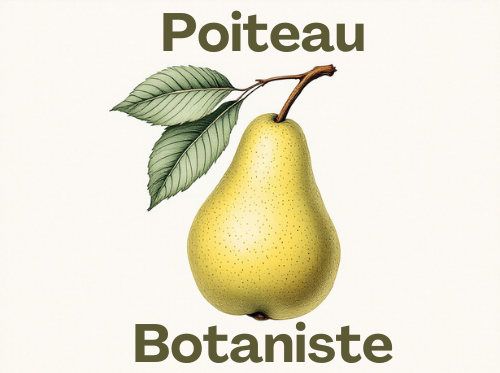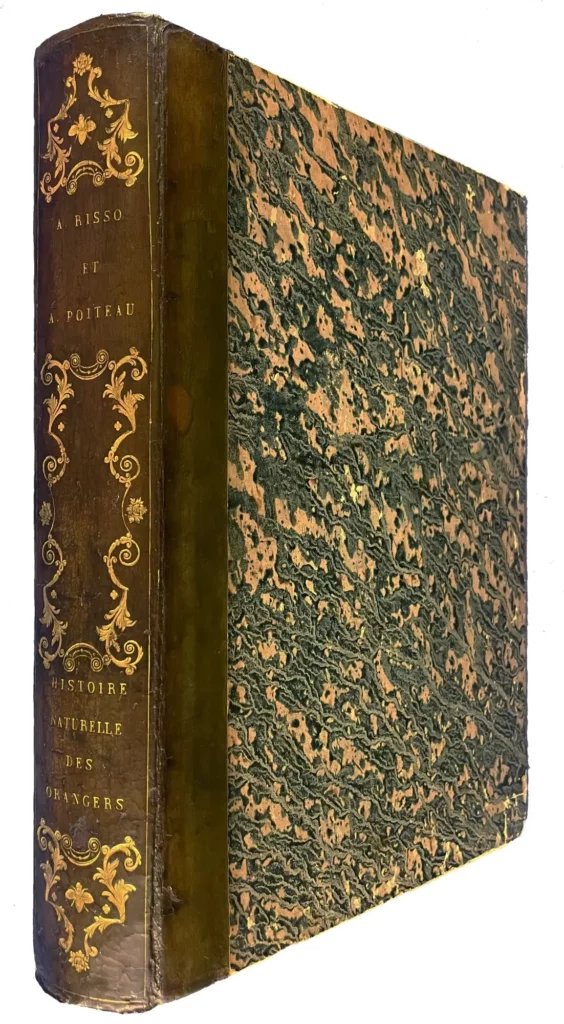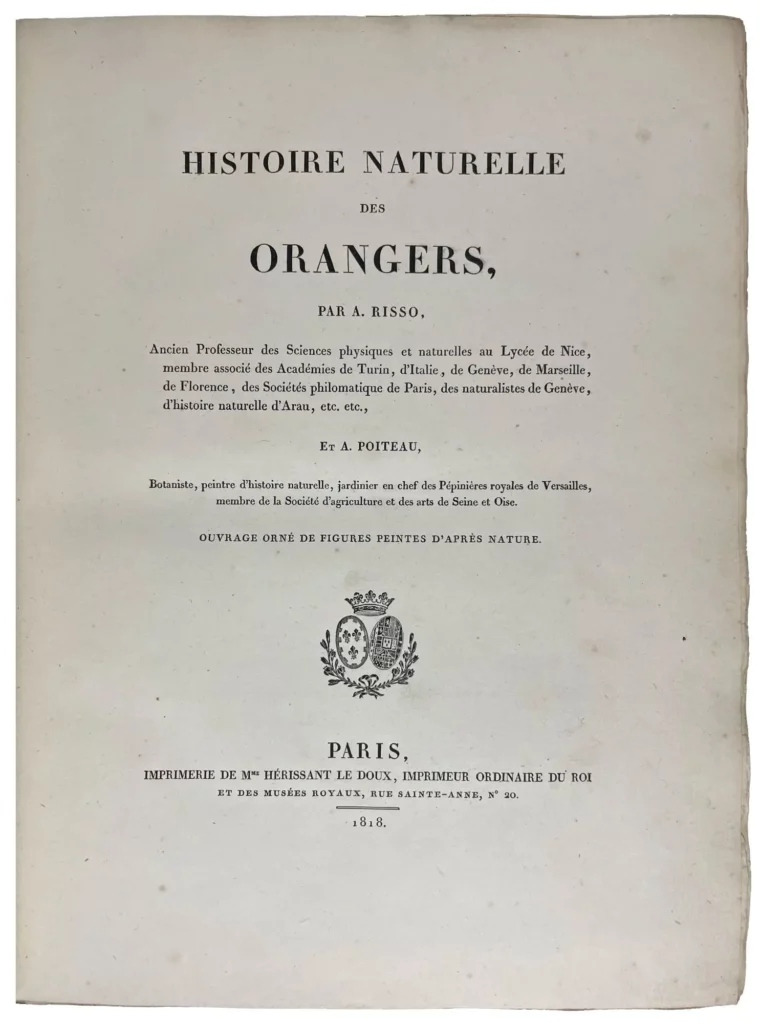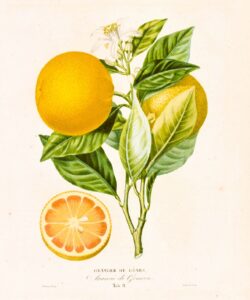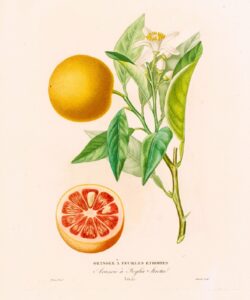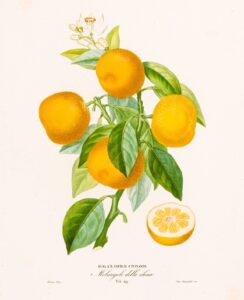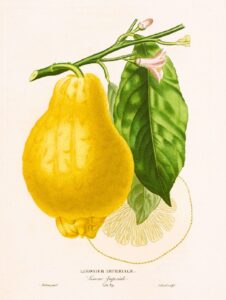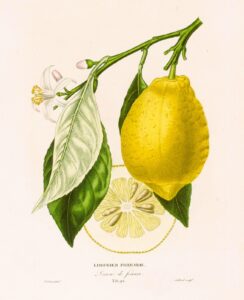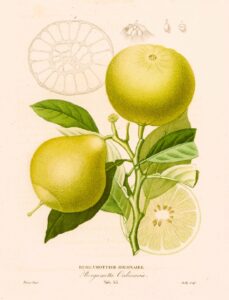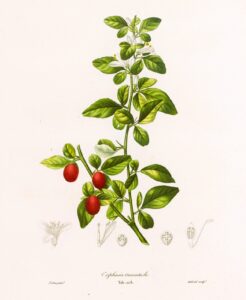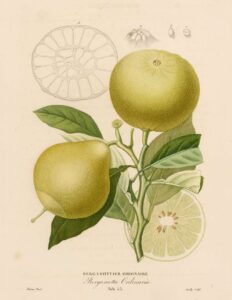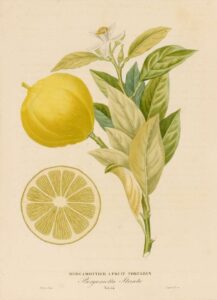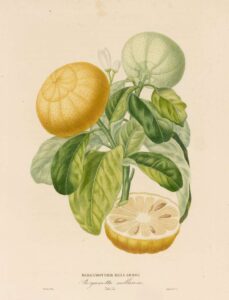The “Histoire Naturelle des Orangers” (Natural History of Orange Trees) is an iconic piece of the 19th century, the result of the collaboration between Antoine Risso and Pierre-Antoine Poiteau. It is often considered the finest book devoted to citrus fruits.

(Photo credit BnF Gallica)
The context
The Histoire Naturelle des Orangers is the culmination of decades of observation, research, and botanical drawing. It demonstrates the expertise of Pierre-Antoine Poiteau, a self-taught man who became one of the greatest botanists of his time.
Born in 1766 into a modest family, Poiteau discovered a fascination with nature and plants at a young age while working as a gardener. This passion was fueled by his apprenticeship at the Jardin des Plantes in Paris , where he was taken under the wing of the famous french botanist André Thouin . There, Poiteau acquired botanical skills and distinguished himself by his ability to draw plants with remarkable attention to detail.
Poiteau, with his expertise as a horticulturist, botanist and draftsman , possessed a skill set ideally suited to creating a reference work on orange trees.
His journey took him from the gardens of Paris to Santo Domingo and the greenhouses of the Palace of Versailles, offering him a unique perspective on the diversity of orange trees and their particularities.
It was during his assignment as head of the nursery at Versailles (1815-1818) that he was able to gather the first elements and design the project for the book. This period allowed him to deepen his knowledge of fruit trees and to mature his project.
The collaboration between Risso and Poiteau: a meeting of talents
Given the ambition of his project, Poiteau called upon Risso, a naturalist from southern France, for his in-depth knowledge of orange trees. Risso had already published an interesting memoir on the orange trees of the Alpes-Maritimes in the Annales du Muséum. Poiteau, for his part, had no opportunity to observe orange trees himself in southern France.
The collaboration between Poiteau and Risso proved fruitful:
- Risso wrote the text of the book, bringing his scientific expertise and knowledge of the history and classification of orange trees
- Poiteau created the drawings, depicting the orange trees, their leaves, flowers, and fruit with great precision and attention to detail. He drew, engraved, and printed the samples promptly sent by Risso, who allowed him to complete his illustrative work.
The book benefited from the financial support of Mr. de Montalivet and Mr. Decazes, Ministers of the Interior, who subscribed to a considerable number of copies, thus ensuring its success.
The fruit of this collaboration, Histoire Naturelle des Orangers , was published from July 1818 in the form of booklets by the publisher Audot.
(Photo credit: Donald A. Heald / Rare Books, prints & maps)
Poiteau was still finalizing the last plates in December 1818 , while he was in his place as head of the tree nurseries at the Palace of Versailles. It was at this time that a new opportunity presented itself to him: a trip to Guiana, where he would continue his botanical explorations.
Through the work Histoire Naturelle des Orangers, Poiteau was involved in:
- Observation and study of specimens :
- He analyzes local and tropical varieties of orange, mandarin, citron, grapefruit and lime trees.
- His botanical travels and studies in Paris allowed him to document rare or little-known specimens.
- The botanical illustration :
- Poiteau created the 109 engraved plates that illustrate the book. These illustrations, executed in dotted lines and colored by hand, faithfully capture the details of the leaves, flowers, and fruits.
(Photo credit: BnF Gallica)
Publication: a triumph in 1822
The Histoire Naturelle des Orangers was published in a single folio volume and quickly became a standard book on citrus fruits. It combined rigorous scientific descriptions with illustrations of exceptional artistic quality.
- Scientific contributions :
The artwork lists numerous varieties of citrus fruits, their origins, their morphological characteristics and their uses, both food and industrial. - Remarkable realism and finesse :
Poiteau’s illustrations were praised for their thoroughness and faithfulness to real specimens . He depicted not only fruits, but also leaves, flowers, and essential botanical details , making them a valuable tool for scientists and horticulturists.
Upon its publication, the Histoire Naturelle des Orangers received a favorable reception. Extract from the biography of Poiteau by M. Choron in 1882:
“The famous naturalists Thouin and Bosc, from the very appearance of the book, proclaimed its merit, declaring it as complete as it was scholarly. Likewise, the assembly on the same branch of the leaves, flowers and fruits of the orange tree, in the pose and color that nature gives them, makes each figure a living and animated picture that one cannot admire too much.”
Today, the book “Histoire Naturelle des Orangers” is considered one of the pinnacles of 19th-century botanical illustration. Even today, these plates are highly sought after on the art market , where they are often sold as framed prints.
A botanical anecdote: Bergamot and the work of Risso and Poiteau
Did you know that bergamot, the captivatingly fragrant citrus fruit that gives its aroma to the famous Earl Grey tea, bears the Latin name Citrus bergamia ? Although this name was given in the 18th century, it was thanks to the artwork “Histoire Naturelle des Orangers” that this citrus fruit found its definitive place in botanical history.
In this book, Pierre-Antoine Poiteau and Antoine Risso describe the bergamot tree in detail , documenting its unique characteristics and its role in perfumery and gastronomy. Poiteau, a true botanical artist, also created remarkably fine illustrations, highlighting the leaves, flowers, and fruit.
Thus, through the Histoire Naturelle des Orangers, Risso and Poiteau not only contributed to a better understanding of this citrus fruit, but also to popularizing its use and consolidating its botanical identity. Moreover, the name ‘Citrus Bergamia Risso et Poiteau’ is still used in scientific publications.
The next time you enjoy a cup of Earl Grey tea, consider this subtle connection between botanical history and this unique fruit!
The following plates show the different species of bergamot:
(Photo credit: BnF Gallica)
If you would like to browse this book, I invite you to discover the digital version of the Natural History of Orange Trees made available by the National Library of France (BnF) on the Gallica site.
📖 Also read: Discover his other major books, such as Traité des arbres fruitiers, nouvelle edition and Pomologie Française .
